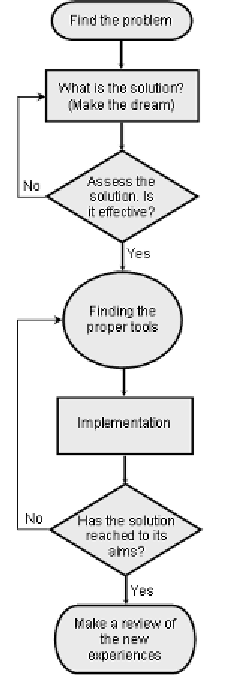Information Technology Reference
In-Depth Information
Figure 2. Decision making in engineering pro-
cesses
engineer is who dreams, then assesses the realiza-
tion possibilities of the dream and finally makes
the dream a reality. Therefore an engineering
student on one hand should have the talent and on
the other hand has to be trained up appropriately
to be able to follow the steps of an engineering
decision according to Figure 2 and to create and
find the answers for questions like:
1. What is the problem?
2. What do I want to do?
3. What are the benefits of this solution? And
are they significant?
4. How can I implement the solution?
5. How can I know that if I have reached the
benefits?
6. How can I represent a better solution with
my new experiences?
4. EngInEErIng EducAtIon
rEquIrEmEntS
In a continuously changing world, many chal-
lenges and opportunities face the engineering
profession and engineering education. Based on
various technological and economic develop-
ments, fundamental changes have taken place
over the last few years that affect the methods
in engineering education. In consequence, the
actual training trends like the trend to virtual
and classical Instructional methods, the global
availability of information on one hand and of
information resources and accessibility on the
other hand, the rise of learning demands and the
particularities of engineering education require
a strategic streamlining of each of these options.
The basis for this strategic planning should be the
instructional principal abilities and the use of the
general available enabling technologies.
Engineering professionals working in industry
are in general unsatisfied with the level of real-
world preparedness acquired by recent university
graduates entering the work market. Their dis-
satisfaction is understandable. In order for these
graduates to be productive in an industrial setting,
one idea is that the organizations which hire them
must supplement their university education with
extensive on-the-job training and preparation that
provides them with the skills and knowledge they
lack (Conn 2002; Baker 2005).
On the other hand, following the tremendous
progress in science and technology, engineering
teaching materials are currently under develop-
ment by the multidisciplinary (production engi-
neers, computer scientists, economists) project
teams. The philosophy behind this approach is
to give access to all information that is relevant
to understand and to work on the topic of inter-
est. The background of the didactic approach of

Search WWH ::

Custom Search